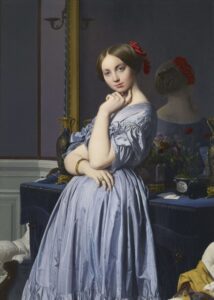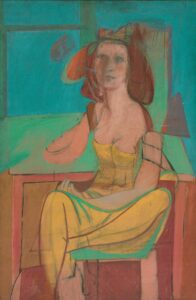Sam Woodworth
Portland, Maine

I recently had the opportunity to visit the Frick Collection in New York City and was delighted to see Portrait of Comtesse d’Haussonville, a beautiful painting by the nineteenth-century French neoclassical artist, Jean Auguste Dominique Ingres. The subject of the painting, Louise de Broglie, appears to have just returned from a show and put down her opera glasses before turning to pose. Ingres’s sinuous line serves to outline de Broglie in space, but it also creates an uncanny sense of movement.
Like generations of viewers before me, I found myself transfixed beneath Ingres’s portrait—so much human emotion from a transient moment captured in oil paint. The work also happens to be an example of anatomical and visual deceit. The severe angling of de Broglie’s right arm means it cannot possibly connect to her unseen shoulder. The image in the mirror adds another impossibility, as the reflected finger would not in reality be visible. This dissonance becomes part of Ingres’s thrilling paradox: the image is static, yet de Broglie shudders with movement and breathes with life.
In 1926, a twenty-two-year-old Dutch painter with a deep appreciation for the work of Ingres immigrated to America. This artist’s name was Willem de Kooning. He had stowed away for two weeks in the engine room of a British freighter called the SS Shelley. Carrying along few possessions and speaking very little English, de Kooning set out with unabashed curiosity and a pure hope in the burgeoning cultural wellspring of 1920s New York City. Unbeknownst to himself, he would go on to become one of America’s greatest 20th century painters, helping to establish New York City as the world’s epicenter for a new modern art: abstract expressionism.
After arriving in America, de Kooning met another immigrant painter, Arshile Gorky, who had fled the atrocities of the Armenian genocide several years earlier. De Kooning and Gorky became fast friends. They furiously discussed their ideas about art, confronting obstacles in their own painting and celebrating artists whose work excited them, Ingres included. They lived in the more modest neighborhoods of lower Manhattan but would often make the uptown trek to the Upper East Side to visit the art museums and talk shop.
Of course, de Kooning and Gorky would often find their way to the Frick Collection and take in Ingres’s Portrait of Comtesse d’Haussonville. One can imagine heady conversations between the two painters, wondering aloud how Ingres used a subtle variation in blue to illustrate depth in de Broglie’s dress, or why Ingres cut a line through his picture here rather than there, and what her pose said about her state of mind. Deep in conversation, de Kooning and Gorky considered their own work through the lens of an old master, creating new ideas and pushing the boundaries of modern art in America.

In 1940, de Kooning painted Seated Woman. Taken alongside Portrait of Comtesse d’Haussonville, the similarities are readily apparent (the paintings are also nearly identical in size). Both works hold the image of a woman, her pose static but with an undeniable sense of movement, brought to life by line and color. But the differences are radical. De Kooning offers abstracted shapes and forces his viewer to amalgamate a living figure. His seated woman must be teased out from a brightly colored background, one which overlaps the strongly defined outlines of her legs and the impression of a dress or skirt. Partially erased sketching and de Kooning’s visible iterations of the image add a further sense of movement and time passed. Although the two paintings were created nearly one hundred years apart, Seated Woman echoes Portrait of Comtesse d’Haussonville and vice versa, each adding a new perspective to the other.
De Kooning went on to have an illustrious career, developing several distinct styles of painting throughout the 1940s and 1950s. Repeatedly reinventing himself, he maintained the spirit of a peripatetic immigrant, visiting and revisiting abstraction, the human figure, and landscapes (often within the same work of art). Even as he developed Alzheimer’s disease later in life, de Kooning maintained a daily habit of painting, taking his signature brushwork to new ethereal heights in using sparse ribbons of primary colors.
Reflecting on the story of Ingres and de Kooning, I began to consider my role as a physician through the lens of these painters and their creations. Both medicine and art are human endeavors imbued with a relentless quest for answers to difficult questions. Within the story of de Kooning’s journey to the Frick Collection in New York City, several themes emerge that apply to the practice of medicine.
By leaving home and immigrating to a new country, de Kooning showed a great sense of exploration and curiosity. As a physician, I hope to approach my practice with such spirit. Patients deserve curious physicians who find joy and meaning in looking beneath previously unturned stones. Curiosity also serves to bolster empathic care. As famously said by Francis Peabody, the secret of the care of the patient is in caring for the patient. Echoing this sentiment, I hope to sustain curiosity to better serve and understand my patients.
De Kooning and Gorky found true companionship in one another. In the hectic, fast-paced world of modern medicine, I believe many physicians could likewise benefit from building meaningful social connections within medical teams. Attendings, residents, and medical students alike—we can all foster resilience through companionship on the wards, offering and receiving emotional support as a group.
Imitating Ingres provided de Kooning with a scaffolding to develop his own ideas about art. De Kooning and Gorky also borrowed from one another, reacting to each other’s work and pushing themselves to the cusp of modern art. I feel empowered to imitate other physicians whose work or style at the bedside I greatly admire. By picking up new traits and personalizing them, I hope to become a better listener, a better thinker, and a better teacher.
Lastly, de Kooning sought out and celebrated reinvention throughout his career. Welcoming fresh perspectives, he was able to approach difficult problems in his art with new solutions. As a physician, I recognize the need to be a life-long learner. By sustaining a growth mindset and being open to the prospect of reinvention, I know that I can discover new ways of communicating with patients and charge my work with a deeper, regenerative purpose.
I plan to revisit the Frick Collection, practicing iteration and reflection just as de Kooning must have done. Standing beneath Portrait of Comtesse d’Haussonville and reconsidering Ingres’s enduring paradox—the creation of movement and life in a still image—I am sure that these visits will enrich my experience as a physician and improve the care of my patients. I hope to continue searching for what might be hiding in plain sight.
Reference
Stevens, Mark. De Kooning: An American Master. New York: A.A. Knopf, 2006.
SAM WOODWORTH, MD, is a hospitalist at Maine Medical Center in Portland, Maine. He completed his internal medicine training including a chief medical residency at Beth Israel Deaconess Medical Center in Boston, Massachusetts. Dr. Woodworth is currently working to establish a museum-based arts course for medical students and believes that experiences with art can heighten curiosity and strengthen diagnostic creativity.

Leave a Reply